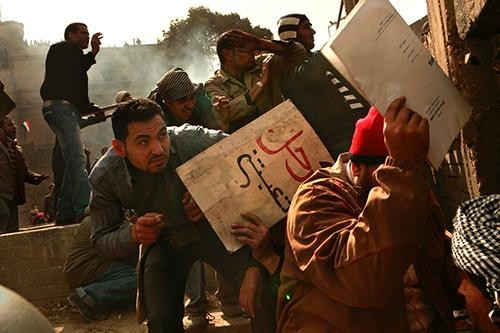CAIRO — The day after Wednesday’s rampage, blood stained the streets of Tahrir Square. It oozed through the bandages wrapping the heads of the protesters and crusted around their bleary eyes. People walked around in a daze, barely able to articulate what had been done to them or what they had dealt out in return.
One man, a 30-year-old lawyer named Tareq Hussein Ali, whose sweatshirt was so bloodied it looked like a red-brown bib, ventured his analysis. “”Egypt will never be as it used to be,”” he said.
In the battle for Tahrir Square, the heart of Egypt’s 10-day uprising against U.S.-allied President Hosni Mubarak’s 30-year rule, the protesters took on and ultimately prevailed over the pro-government gangs sent in to beat them.
In a highly choreographed but primitive siege, played out before a worldwide television audience, the attackers launched gasoline bombs and skull-sized stones from rooftops and bridges or galloped through the teeming square on horses and camels.
When dawn broke Thursday, the square was smoldering, shaken and heavily damaged, but the protesters were unmoved. At least five people had died, Egyptian officials said. At the north end, in the shadow of Egypt’s world-famous antiquities museum, a line of young male demonstrators stood behind a wall of metal sheets that they used as shields, two vehicles they’d set ablaze as a barricade burned down to their hulls, their attackers seemingly melted away.
Holding on to the square for least one more day may not be enough to force Mubarak to resign, as the movement is demanding. The battle had clearly exhausted protesters as they tried to assemble another massive demonstration for Friday, which they’ve dubbed Mubarak’s “”day of departure.””
But the activists showed the extent of their resolve, and some seemed to think that they’d won a pivotal moment in their country’s history.
“”Last night showed that the government is at the last of their options,”” Ali said Thursday afternoon, sitting on a grass patch in the middle of Tahrir — which means “”liberation”” — where dozens of protesters were resting under anti-government banners.
Tahrir on Thursday resembled a bustling open-air triage center. With businesses locked up long ago, young women in head scarves served water to demonstrators from inside a Hardee’s while weary-looking men sporting bandages dozed on the doorsteps of travel agencies, too many to count.
At every entrance to the square, protesters had set up security cordons backed up by neatly arranged lines of stones, in case of another attack. As in previous days, the Egyptian army presence was thin, just a few dozen soldiers looking on, and no uniformed police were in sight.
In a back alley, volunteers set up an emergency medical clinic, where doctors in dirtied white coats re-dressed wounds from the previous night. Hussein Dawood, a physician, said that more than 3,000 people had been injured, a figure that far exceeded the government’s count.
“”We want the whole world to know that the Egyptian president organized an operation against his own people,”” Ali said, “”as if he was in a war.””
When Ali left his Cairo home Jan. 25 to join the first day of the protests, he told his parents: “”I will come home victorious, or you will receive my dead body.”” Late Wednesday night, after nearly 10 hours of running battles in and around the square, he was on the front lines near the museum alongside scores of young male demonstrators.
On an overpass a few hundred yards away, pro-Mubarak forces rained rocks and Molotov cocktails packed with glass shards in Ali’s direction. He received three gashes in his head — the blood running down his face and coating his sweatshirt — and bruises that swelled his left leg to twice its size.
But he and his allies continued a well-organized resistance, hurling rocks and firebombs back at their attackers.
At about the same time, 24-year-old Ahmed Sharkawy, an engineering student, was behind the front line, helping to supply protesters with stones and water. It was after 1 a.m., he said, when a young protester in front of him was struck in the head with a bullet and collapsed to the ground.
Protest organizers said snipers were perched atop nearby buildings, and doctors said they had treated some gunshot wounds. Another activist, Mohammed Gaad, saw gunshots fell five protesters when they briefly seized the overpass from the pro-Mubarak group.
Sharkawy’s own account was hazy, because moments later he was struck in the head with a rock and collapsed.
Speaking with a thick bandage ringing his head, Sharkawy said he left the square for the first time Wednesday morning to retrieve blankets from his home outside Cairo. He raced back when he heard about the clashes.
Beside him sat a pair of brothers who had come to the square that morning, inspired by the previous day’s resistance. As Sharkawy told his story, the older one, Omar Abdul Mansour, 24, nodded in evident awe.
“”This is why I came today,”” Mansour said. “”Either Mubarak leaves or we die.””
In a train station below the square, protest organizers said they were holding dozens of pro-Mubarak attackers, some of whom reportedly carried state security or police ID cards. But Egyptian Vice President Omar Suleiman blamed “”foreign meddling”” for the attacks and said the government hadn’t played a role.
The calm in Tahrir didn’t last long. Clashes erupted again after nightfall Thursday and the crack of automatic gunfire rang out over the square. Activists ran along bridges spanning the Nile River toward suspected attackers, chasing them away, and a few hours later a favorite anti-Mubarak chant rose again from the barricade beside the museum.
“”He must go!”” they said. “”We will never go!””









